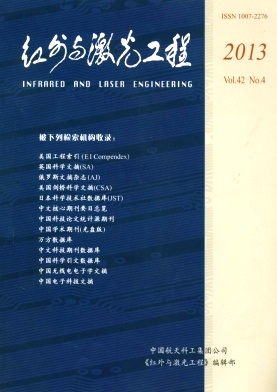|
[1]
|
Guo Rui. Study on general correlative technology of terminal-sensitive submuniton for missile[D]. Nanjing: Nanjing University of Science and Technology, 2006. (in Chinese) 郭锐. 导弹末敏子弹总体相关技术研究[D]. 南京: 南京理工大学, 2006. |
|
[2]
|
|
|
[3]
|
|
|
[4]
|
Yang Shaoqing. Smart Munition Engineering[M]. Beijing: National Defense Industry Press, 2010. (in Chinese) 杨绍卿. 灵巧弹药工程[M]. 北京: 国防工业出版社, 2010. |
|
[5]
|
Xia Xinlin, Ai Qing, Ren Depeng, et al. Numerical analysis on the transient thermal status of aircraft[J]. Acta Aeronautica et Astronautica Sinica, 2007, 28(3): 513-518. (in Chinese) 夏新林, 艾青, 任德鹏, 等. 飞机整体瞬态热状况的数值仿真研究[J]. 航空学报, 2007, 28(3): 513-518. |
|
[6]
|
|
|
[7]
|
|
|
[8]
|
Liu Juan, Gong Guanghong, Han Liang, et al. Modeling and simulation of airplane infrared characteristic[J]. Infrared and Laser Engineering, 2011, 40(7): 1209-1213. (in Chinese) 刘娟, 龚光红, 韩亮, 等. 飞机红外辐射特性建模与仿真[J]. 红外与激光工程, 2011, 40(7): 1209-1213. |
|
[9]
|
|
|
[10]
|
Xu Dingguo, Feng Weilin, Sang Jianhua. IR characteristics of aircraft aft fuselage skin[J]. Infrared and Laser Engineering, 2013, 42(1): 7-13. 徐顶国, 冯维林, 桑建华. 飞行器后机身蒙皮红外辐射特性[J]. 红外与激光工程, 2013, 42(1): 7-13. |
|
[11]
|
Lv Jianwei, Wang Qiang. Coupled analysis on flow field-temperature distribution of aircraft-skin[J]. Journal of Beijing University of Aeronautics and Astronautics, 2009, 35(8): 938-941. (in Chinese) 吕建伟, 王强. 飞行器表面三维流场与固壁温度场的耦合分析[J]. 北京航空航天大学学报, 2009, 35(8): 938-941. |
|
[12]
|
|
|
[13]
|
|
|
[14]
|
Yang Rong, Wang Qiang. Coupled numerical study on aeroheating, radiative heat transfer and structure heat conduction for hypersonic bodies of revolution[J]. Aerospace Shanghai, 2009, 4: 25-29. (in Chinese) 杨荣, 王强. 高超声速旋转体气动加热、辐射换热与结构热传导的耦合数值分析[J]. 上海航天, 2009, 4: 25-29. |
|
[15]
|
Huang Chunsheng, Wu Jie, Fan Xuji. Coupled numerical simulation of supersonic flow field and heated structure of flying vehicles[J]. Mechanics and Engineering, 2004, 26(2): 24-26. (in Chinese) 黄春生, 吴杰, 范绪箕. 飞行器流场与结构温度场耦合数值分析[J]. 力学与实践, 2004, 26(2): 24-26. |
|
[16]
|
|
|
[17]
|
Shan Yong, Zhang Jingzhou, Guo Rongwei. Numerical computation and analysis of the infrared radiation characteristic of missile scarfskin[J]. Journal of Aerospace Power, 2007, 23(2): 251-255. (in Chinese) 单勇, 张靖周, 郭荣伟. 导弹蒙皮红外辐射特性的数值计算与分析[J]. 航空动力学报, 2007, 23(2): 251-255. |
|
[18]
|
|
|
[19]
|
|
|
[20]
|
Zhang Jun. Yang Hua. Theoretical analysis of temperature field on the surface of ballistic missile warhead in midcourse[J]. Infrared and Laser Engineering, 2005, 24(5): 582-586. (in Chinese) 张骏, 杨华. 弹道导弹中段弹头表面温度场分布理论分析[J]. 红外与激光工程, 2005, 24(5): 582-586. |
|
[21]
|
Jiang Chongwen, Cao Yihua, Su Wenhan. Influence of circular angle in symmetric plane to the flowfield characteristics of an axisymmetric parachute[J]. Journal of Beijing University of Aeronautics and Astronautics, 2006, 32(3): 271-275. (in chinese) 蒋崇文, 曹义华, 苏文瀚. 对称面圆周角对轴对称降落伞流场特性的影响[J]. 北京航空航天大学学报, 2006, 32(3): 271-275. |









 DownLoad:
DownLoad: